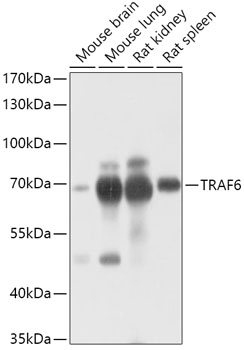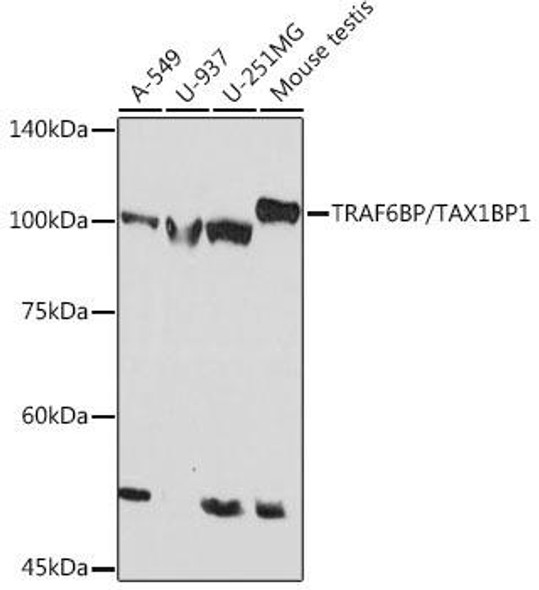Anti-TRAF6 Antibody (CAB16991)
- SKU:
- CAB16991
- Product type:
- Antibody
- Reactivity:
- Human
- Mouse
- Rat
- Host Species:
- Rabbit
- Isotype:
- IgG
- Antibody Type:
- Polyclonal Antibody
- Research Area:
- Epigenetics and Nuclear Signaling
Description
| Antibody Name: | Anti-TRAF6 Antibody |
| Antibody SKU: | CAB16991 |
| Antibody Size: | 20uL, 50uL, 100uL |
| Application: | WB IHC IF |
| Reactivity: | Human, Mouse, Rat |
| Host Species: | Rabbit |
| Immunogen: | A synthetic peptide of human TRAF6. |
| Application: | WB IHC IF |
| Recommended Dilution: | WB 1:500 - 1:2000 IHC 1:50 - 1:200 IF 1:50 - 1:200 |
| Reactivity: | Human, Mouse, Rat |
| Positive Samples: | Mouse brain, Mouse lung, Rat kidney, Rat spleen |
| Immunogen: | A synthetic peptide of human TRAF6. |
| Purification Method: | Affinity purification |
| Storage Buffer: | Store at -20°C. Avoid freeze / thaw cycles. Buffer: PBS with 0.02% sodium azide, 50% glycerol, pH7.3. |
| Isotype: | IgG |
| Sequence: | Email for sequence |
| Gene ID: | 7189 |
| Uniprot: | Q9Y4K3 |
| Cellular Location: | Cytoplasm, Lipid droplet, Nucleus, cell cortex |
| Calculated MW: | 59kDa |
| Observed MW: | 70kDa |
| Synonyms: | TRAF6, MGC:3310, RNF85 |
| Background: | The protein encoded by this gene is a member of the TNF receptor associated factor (TRAF) protein family. TRAF proteins are associated with, and mediate signal transduction from, members of the TNF receptor superfamily. This protein mediates signaling from members of the TNF receptor superfamily as well as the Toll/IL-1 family. Signals from receptors such as CD40, TNFSF11/RANCE and IL-1 have been shown to be mediated by this protein. This protein also interacts with various protein kinases including IRAK1/IRAK, SRC and PKCzeta, which provides a link between distinct signaling pathways. This protein functions as a signal transducer in the NF-kappaB pathway that activates IkappaB kinase (IKK) in response to proinflammatory cytokines. The interaction of this protein with UBE2N/UBC13, and UBE2V1/UEV1A, which are ubiquitin conjugating enzymes catalyzing the formation of polyubiquitin chains, has been found to be required for IKK activation by this protein. This protein also interacts with the transforming growth factor (TGF) beta receptor complex and is required for Smad-independent activation of the JNK and p38 kinases. This protein has an amino terminal RING domain which is followed by four zinc-finger motifs, a central coiled-coil region and a highly conserved carboxyl terminal domain, known as the TRAF-C domain. Two alternatively spliced transcript variants, encoding an identical protein, have been reported. |
| UniProt Protein Function: | TRAF6: E3 ubiquitin ligase that, together with UBE2N and UBE2V1, mediates the synthesis of 'Lys-63'-linked-polyubiquitin chains conjugated to proteins, such as IKBKG, AKT1 and AKT2. Also mediates ubiquitination of free/unanchored polyubiquitin chain that leads to MAP3K7 activation. Leads to the activation of NF- kappa-B and JUN. May be essential for the formation of functional osteoclasts. Seems to also play a role in dendritic cells (DCs) maturation and/or activation. Represses c-Myb-mediated transactivation, in B-lymphocytes. Adapter protein that seems to play a role in signal transduction initiated via TNF receptor, IL- 1 receptor and IL-17 receptor. Regulates osteoclast differentiation by mediating the activation of adapter protein complex 1 (AP-1) and NF-kappa-B, in response to RANK-L stimulation. Homotrimer. Homooligomer. N-terminal region is dimeric while C-terminal region is trimeric; maybe providing a mode of oligomerization. Binds to TNFRSF5/CD40 and TNFRSF11A/RANK. Associates with NGFR, TNFRSF17, IRAK1, IRAK2, IRAK3, IRAK4, RIPK2, MAP3K1, MAP3K5, MAP3K14, CSK, TRAF, TRAF-interacting protein TRIP and TNF receptor associated protein TDP2. Interacts with IL17R. Interacts with SQSTM1 bridging NTRK1 and NGFR. Forms a ternary complex with SQSTM1 and PRKCZ. Interacts with PELI1, PELI2 and PELI3. Binds UBE2V1. Interacts with MAVS/IPS1. Interacts with TAX1BP1. Interacts with IL1RL1. Interacts with TRAFD1. Interacts with ZNF675. Interacts with AJUBA. Interacts with TICAM1 and TICAM2. Interacts with ZFAND5. Interacts with ARRB1 and ARRB2. Interacts with MAP3K7 and TAB1/MAP3K7IP1; during IL-1 signaling. Interacts with UBE2N. Interacts with TGFBR1, HDAC1 and RANGAP1. Interacts with AKT1, AKT2 and AKT3. Interacts (via TRAF domains) with NUMBL (via C-terminal). Interacts (via TRAF domains) with WDR34 (via WD domains). Interacts with RBCK1. Interacts with TRAF3IP2. Interacts with LIMD1 (via LIM domains). Expressed in heart, brain, placenta, lung, liver, skeletal muscle, kidney and pancreas. Belongs to the TNF receptor-associated factor family. A subfamily. |
| UniProt Protein Details: | Protein type:EC 6.3.2.-; Ligase; Ubiquitin conjugating system; Ubiquitin ligase Chromosomal Location of Human Ortholog: 11p12 Cellular Component: cytoplasm; cytosol; endosome membrane; internal side of plasma membrane; lipid particle; mitochondrion; nucleolus; nucleus; perinuclear region of cytoplasm; plasma membrane; protein complex Molecular Function:histone deacetylase binding; identical protein binding; mitogen-activated protein kinase kinase kinase binding; protein binding; protein kinase B binding; protein kinase binding; protein N-terminus binding; thioesterase binding; tumor necrosis factor receptor binding; ubiquitin conjugating enzyme binding; ubiquitin protein ligase binding; ubiquitin-protein ligase activity Biological Process: activation of MAPK activity; activation of NF-kappaB transcription factor; activation of NF-kappaB-inducing kinase; activation of protein kinase activity; I-kappaB kinase/NF-kappaB cascade; JNK cascade; membrane protein intracellular domain proteolysis; MyD88-dependent toll-like receptor signaling pathway; MyD88-independent toll-like receptor signaling pathway; negative regulation of apoptosis; negative regulation of transcription from RNA polymerase II promoter; negative regulation of transcription, DNA-dependent; positive regulation of apoptosis; positive regulation of I-kappaB kinase/NF-kappaB cascade; positive regulation of interleukin-2 production; positive regulation of JNK activity; positive regulation of osteoclast differentiation; positive regulation of T cell activation; positive regulation of T cell cytokine production; positive regulation of transcription factor activity; positive regulation of transcription from RNA polymerase II promoter; protein autoubiquitination; protein polyubiquitination; stimulatory C-type lectin receptor signaling pathway; T cell receptor signaling pathway; toll-like receptor 9 signaling pathway; toll-like receptor signaling pathway |
| NCBI Summary: | The protein encoded by this gene is a member of the TNF receptor associated factor (TRAF) protein family. TRAF proteins are associated with, and mediate signal transduction from, members of the TNF receptor superfamily. This protein mediates signaling from members of the TNF receptor superfamily as well as the Toll/IL-1 family. Signals from receptors such as CD40, TNFSF11/RANCE and IL-1 have been shown to be mediated by this protein. This protein also interacts with various protein kinases including IRAK1/IRAK, SRC and PKCzeta, which provides a link between distinct signaling pathways. This protein functions as a signal transducer in the NF-kappaB pathway that activates IkappaB kinase (IKK) in response to proinflammatory cytokines. The interaction of this protein with UBE2N/UBC13, and UBE2V1/UEV1A, which are ubiquitin conjugating enzymes catalyzing the formation of polyubiquitin chains, has been found to be required for IKK activation by this protein. This protein also interacts with the transforming growth factor (TGF) beta receptor complex and is required for Smad-independent activation of the JNK and p38 kinases. This protein has an amino terminal RING domain which is followed by four zinc-finger motifs, a central coiled-coil region and a highly conserved carboxyl terminal domain, known as the TRAF-C domain. Two alternatively spliced transcript variants, encoding an identical protein, have been reported. [provided by RefSeq, Feb 2012] |
| UniProt Code: | Q9Y4K3 |
| NCBI GenInfo Identifier: | 30580642 |
| NCBI Gene ID: | 7189 |
| NCBI Accession: | Q9Y4K3.1 |
| UniProt Secondary Accession: | Q9Y4K3,Q8NEH5, A6NKI7, A8KAB3, D3DR16, |
| UniProt Related Accession: | Q9Y4K3 |
| Molecular Weight: | 59,573 Da |
| NCBI Full Name: | TNF receptor-associated factor 6 |
| NCBI Synonym Full Names: | TNF receptor associated factor 6 |
| NCBI Official Symbol: | TRAF6 |
| NCBI Official Synonym Symbols: | RNF85; MGC:3310 |
| NCBI Protein Information: | TNF receptor-associated factor 6 |
| UniProt Protein Name: | TNF receptor-associated factor 6 |
| UniProt Synonym Protein Names: | E3 ubiquitin-protein ligase TRAF6; Interleukin-1 signal transducer; RING finger protein 85; RING-type E3 ubiquitin transferase TRAF6Curated |
| Protein Family: | TNF receptor-associated factor |
| UniProt Gene Name: | TRAF6 |






